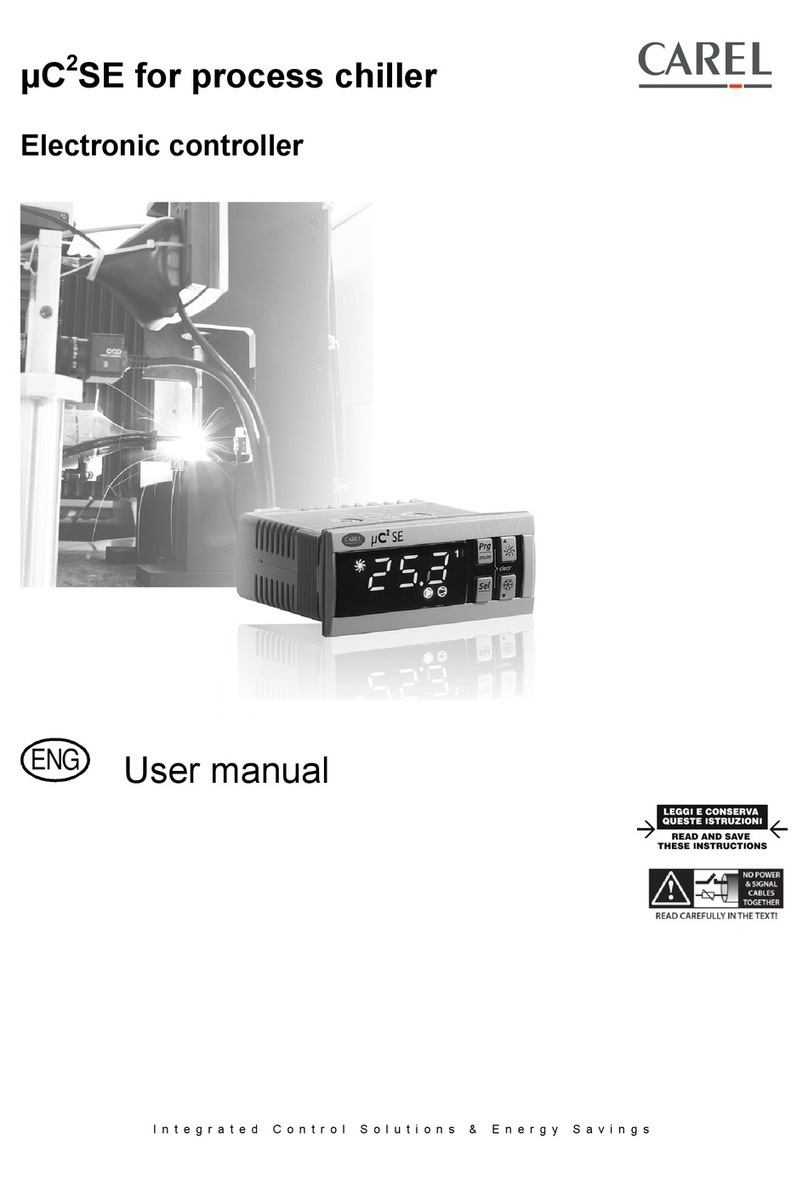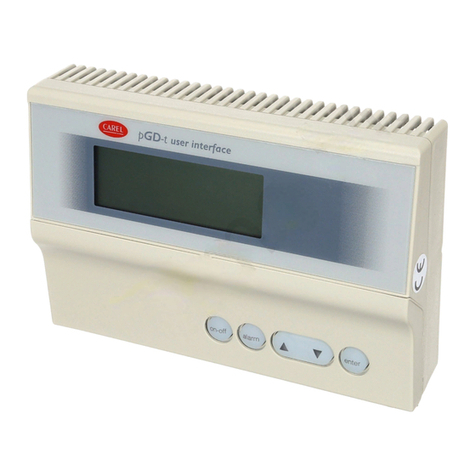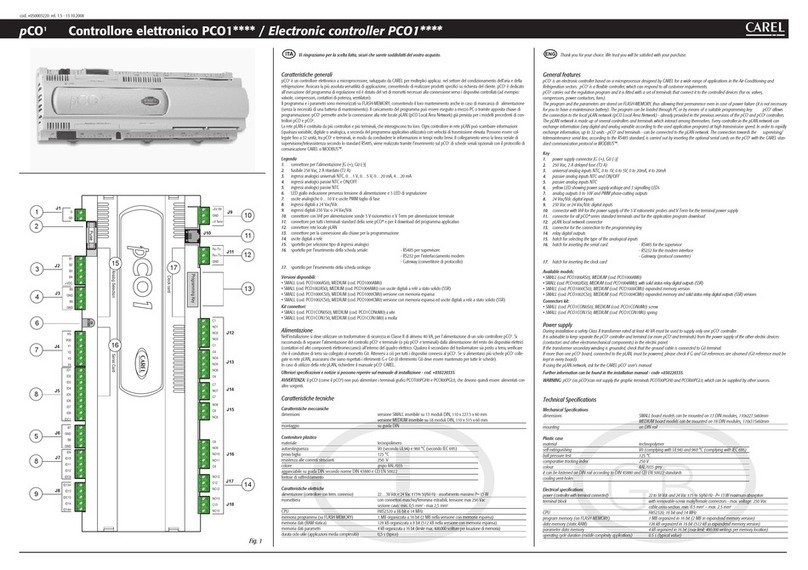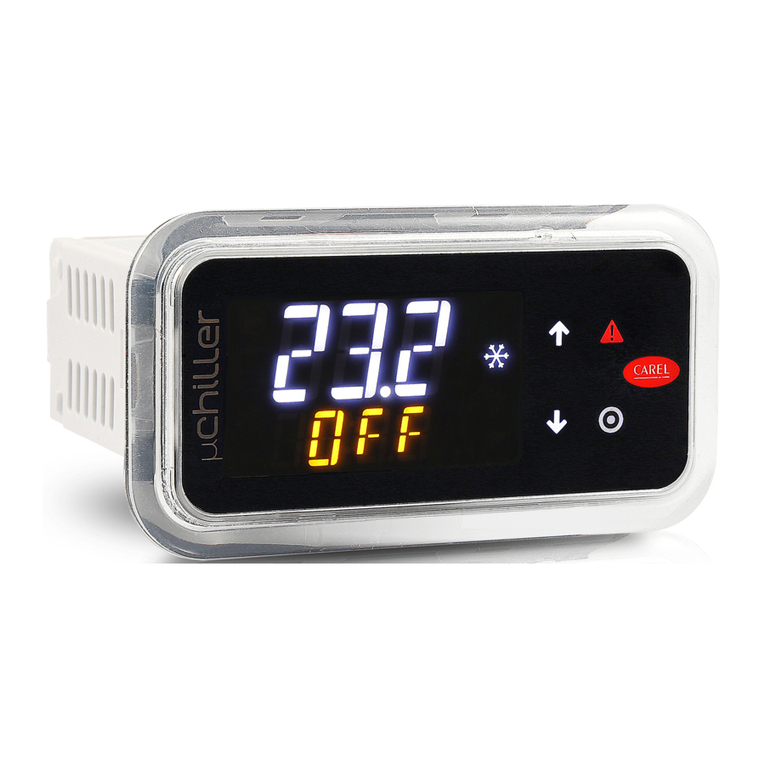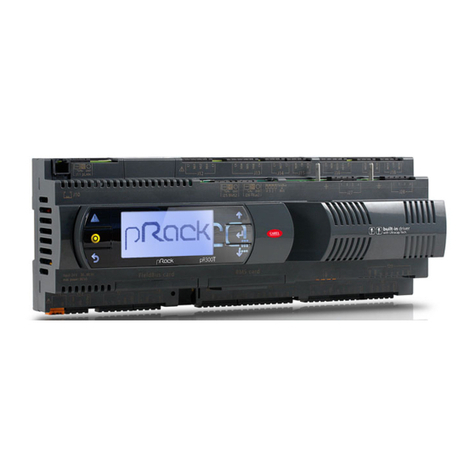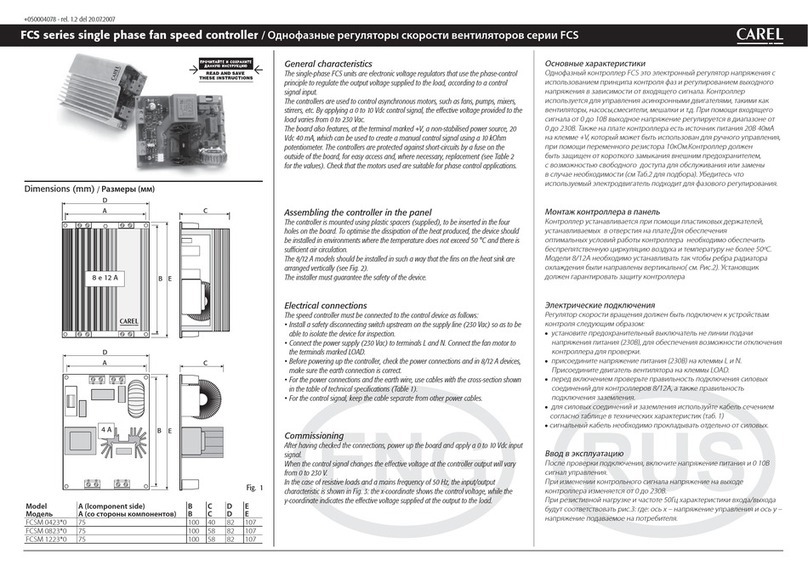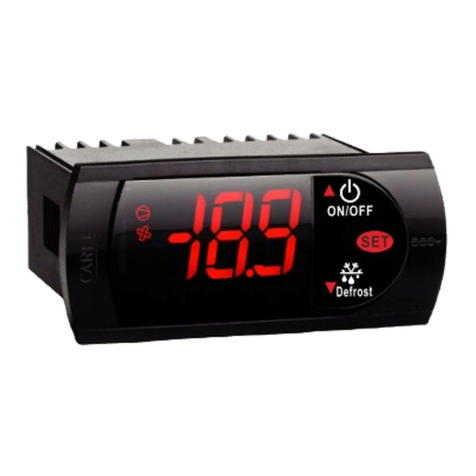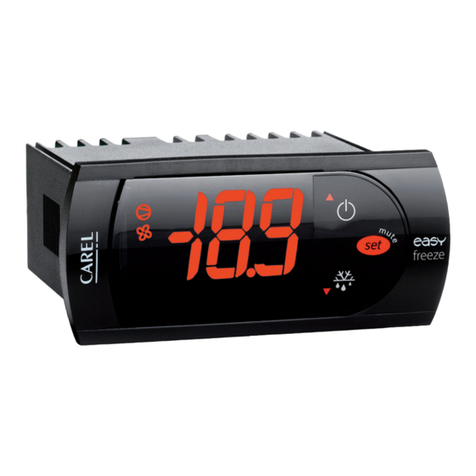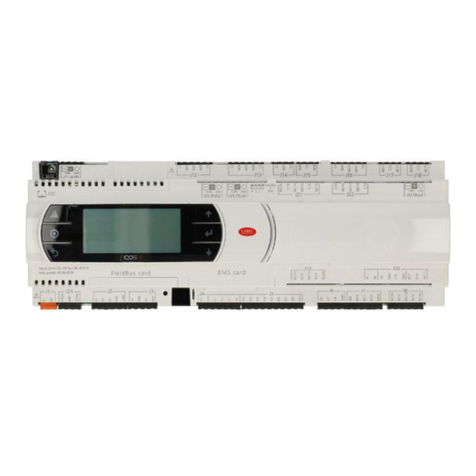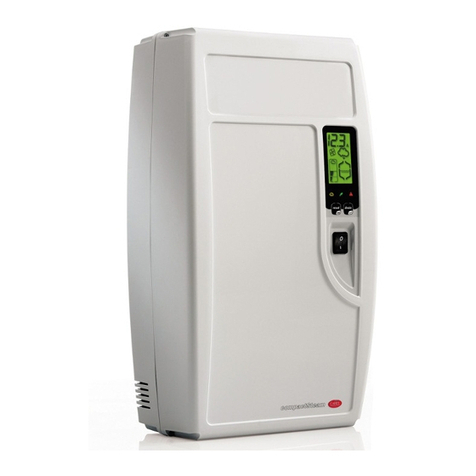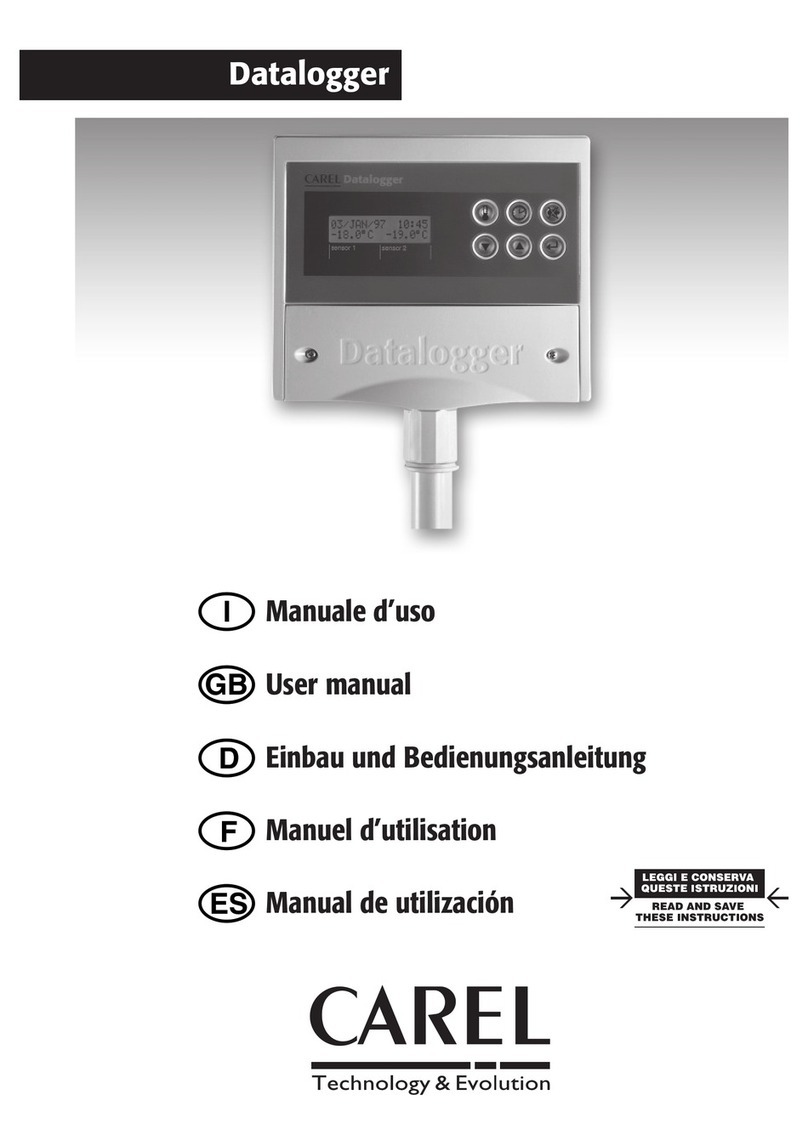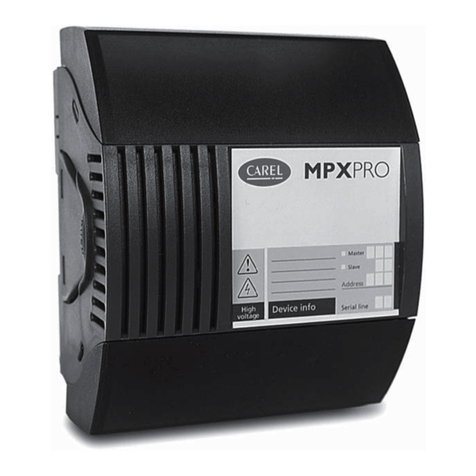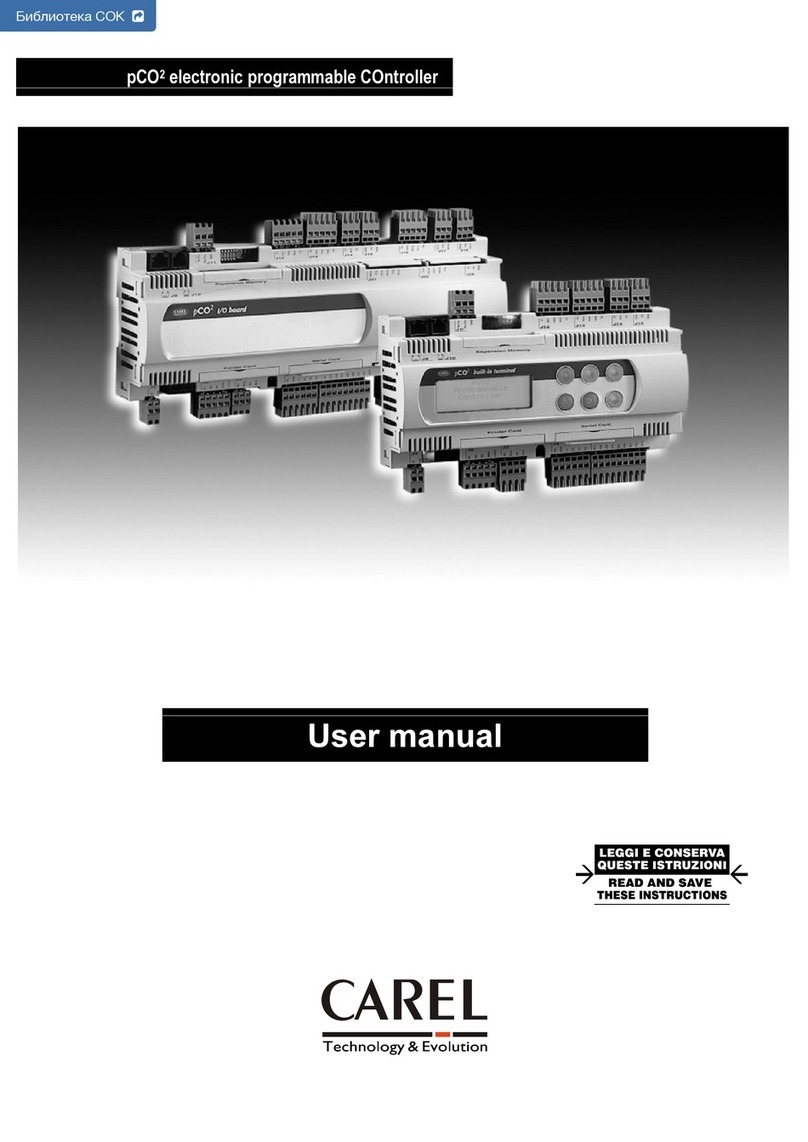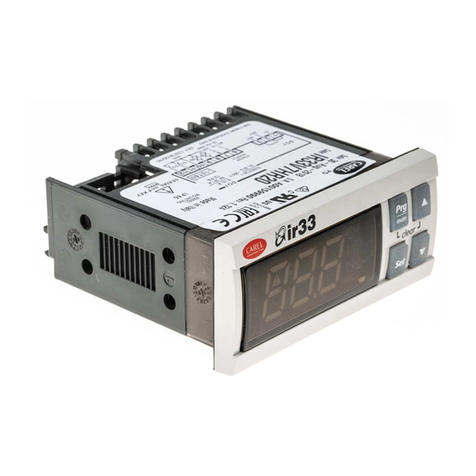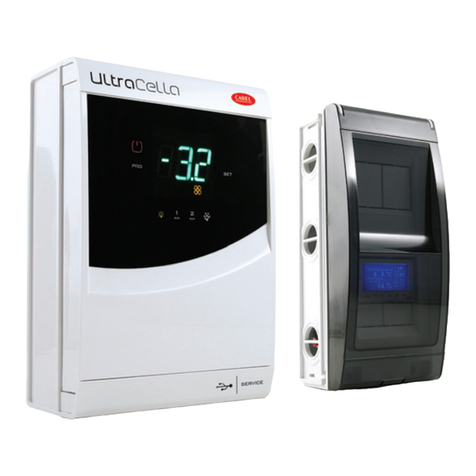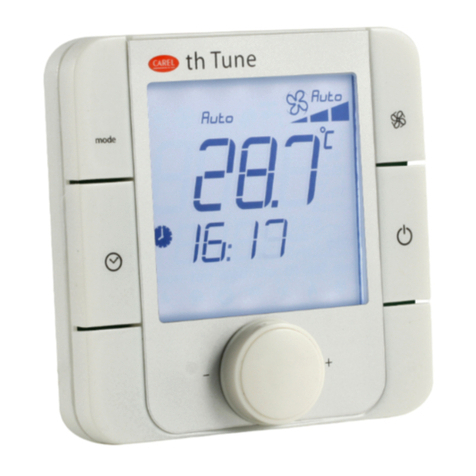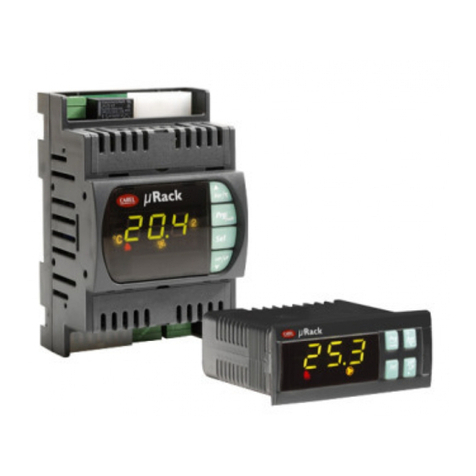Thank you for your choice. We trust you will be satisfied with your purchase.
General features
pCO
1
is an electronic controller based on a microprocessor designed by CAREL for a wide range of applications in the Air-Conditioning and
Refrigeration sectors. pCO
1
is a flexible controller, which can respond to all customer requirements.
pCO
1
carries out the regulation program and it is fitted with a set of terminals that connect it to the controlled devices (for ex. valves,
compressors, power contactors, fans).
The program and the parameters are stored on FLASH-MEMORY, thus allowing their permanence even in case of power failure (it is not
necessary for you to have a maintenance battery). The program can be loaded through PC or by means of a suitable programming key.
pCO
1
allows the connection to the local pLAN network (pCO Local Area Network) - already provided in the previous versions of the pCO and
pCO
2
controllers.
The pLAN network is made up of several controllers and terminals which interact among themselves. Every controller in the pLAN network can
exchange information (any digital and analog variable according to the used application program) at high transmission speed. In order to
rapidly exchange information, up to 32 units - pCO
1
and terminals - can be connected to the pLAN network. The connection towards the
supervising/telemaintenance serial line, according to the RS485 standard, is carried out by inserting the optional serial cards on the pCO
1
with
the CAREL standard communication protocol or MODBUS™.
Key
1. power supply connector [G (+), G0 (-)]
2. 250 Vac, 2 A delayed fuse (T2 A)
3. universal analog inputs NTC, 0 to 1V, 0 to 5V, 0 to 20mA, 4 to 20mA
4. passive analog inputs NTC and ON/OFF
5. passive analog inputs NTC
6. yellow LED showing power supply voltage and 3 signalling LEDs
7. analog outputs 0 to 10V and PWM phase-cutting outputs
8. 24 Vac/Vdc digital inputs
9. 230 Vac or 24 Vac/Vdc digital inputs
10. connector with Vrif for the power supply of the 5 V ratiometric probes and V Term for the terminal power supply
11. connector for all pCO* series standard terminals and for the application program download
12. pLAN local network connector
13. connector for the connection to the programming key
14. relay digital outputs
15. hatch for selecting the type of the analogical inputs
16. hatch for inserting the serial card: - RS485 for the supervisor
- RS232 for the modem interface
- Gateway (protocol converter)
17. hatch for inserting the clock card
Available models:
• SMALL (cod. PCO1000AS0), MEDIUM (cod. PCO1000AM0)
• SMALL (cod. PCO1002AS0), MEDIUM (cod. PCO1004AM0), with solid status relay digital outputs (SSR)
• SMALL (cod. PCO1000CS0), MEDIUM (cod. PCO1000CM0) expanded memory version
Connectors kit:
• SMALL (cod. PCO1CON0S0), MEDIUM (cod. PCO1CON0M0) screw
• SMALL (cod. PCO1CON1S0, MEDIUM (cod. PCO1CON1M0) spring
Power supply
During installation a safety Class II transformer rated at least 40 VA must be used to supply only one pCO
1
controller.
It is advisable to keep separate the pCO
1
controller and terminal (or more pCO
1
and terminals) from the power supply of the other electric devices
(contactors and other electromechanical components) in the electric panel.
If the transformer secondary winding is grounded, check that the ground cable is connected to G0 terminal.
If more than one pCO
1
board, connected to the pLAN, must be powered, please check if G and G0 references are observed (G0 reference
must be kept in every board).
If using the pLAN network, ask for the CAREL pCO
1
user’s manual.
Further information can be found in the installation manual - code +030221840.
WARNING: pCO
1
(as pCO
2
)can not supply the graphic terminals PCOT00PGH0 and PCOI00PGL0, which can be supplied by other sources.
Technical Specifications
Mechanical Specifications
dimensions SMALL board models can be mounted on 13 DIN modules, 110x227.5x60mm
MEDIUM board models can be mounted on 18 DIN modules, 110x315x60mm
mounting on DIN rail
Plastic case
material technopolymer
self-extinguishing V0 (complying with UL94) and 960 °C (complying with IEC 695)
ball pressure test 125 °C
comparative tracking index 250 V
colour RAL7035 grey
it can be fastened on DIN rail according to DIN 43880 and CEI EN 50022 standards
cooling vent-holes
Electrical specifications
power (controller with terminal connected) 22 to 38 Vdc and 24 Vac ±15 % 50/60 Hz - P= 13 W maximum absorption
terminal block with removable-screw male/female connectors - max. voltage: 250 Vac
cable cross-section: min. 0.5 mm
2
– max. 2.5 mm
2
CPU H8S2320, 16 bit and 14 MHz
program memory (on FLASH MEMORY) 1 MB organized in 16 bit (2 MB in expandend memory version)
data memory (static RAM) 128 kB organized in 16 bit (512 kB in expandend memory version)
parameter data memory 4 kB organized in 16 bit (max limit: 400.000 writings per memory location)
operating cycle duration (middle complexity applications) 0.5 s (typical value)
Vi ringraziamo per la scelta fatta, sicuri che sarete soddisfatti del vostro acquisto.
Caratteristiche generali
pCO1è un controllore elettronico a microprocessore, sviluppato da CAREL per molteplici applicaz. nel settore del condizionamento dell'aria e della
refrigerazione. Assicura la più assoluta versatilità di applicazione, consentendo di realizzare prodotti specifici su richiesta del cliente. pCO1è
dedicato all'esecuzione del programma di regolazione ed è dotato del set di morsetti necessari alla connessione verso i dispositivi controllati
(ad esempio: valvole, compressori, contattori di potenza, ventilatori).
Il programma e i parametri sono memorizzati su FLASH-MEMORY, consentendo il loro mantenimento anche in caso di mancanza di
alimentazione (senza la necessità di una batteria di mantenimento). Il caricamento del programma può essere eseguito a mezzo PC o tramite
apposita chiave di programmazione. pCO1permette anche la connessione alla rete locale pLAN (pCO Local Area Network) già prevista per i
modelli precedenti di controllori pCO e pCO2.
La rete pLAN è costituita da più controllori e più terminali, che interagiscono tra loro. Ogni controllore in rete pLAN può scambiare informazioni
(qualsiasi variabile, digitale o analogica, a seconda del programma applicativo utilizzato) con velocità di trasmissione elevata. Possono essere
collegate fino a 32 unità, tra pCO1e terminali, in modo da condividere le informazioni in tempi molto brevi. Il collegamento verso la linea seriale di
supervisione/teleassistenza secondo lo standard RS485, viene realizzato tramite l'inserimento sul pCO1di schede seriali opzionali con il protocollo
di comunicazione CAREL o MODBUS™.
Legenda
1. connettore per l’alimentazione [G (+), G0 (-)]
2. fusibile 250 Vac, 2 A ritardato (T2 A)
3. ingressi analogici universali NTC, 0…1 V, 0…5 V, 0…20 mA, 4…20 mA
4. ingressi analogici passivi NTC e ON/OFF
5. ingressi analogici passivi NTC
6. LED giallo indicazione presenza tensione di alimentazione e 3 LED di segnalazione
7. uscite analogiche 0…10 V e uscite PWM taglio di fase
8. ingressi digitali a 24 Vac/Vdc
9. ingressi digitali 230 Vac o 24 Vac/Vdc
10. connettore con Vrif per alimentazione sonde 5 V raziometrici e V Term per alimentazione terminale
11. connettore per tutti i terminali standard della serie pCO* e per il download del programma applicativo
12. connettore rete locale pLAN
13. connettore per la connessione alla chiave per la programmazione
14. uscite digitali a relè
15. sportello per selezione tipo di ingressi analogici
16. sportello per l’inserimento della scheda seriale: - RS485 per supervisore
- RS232 per l’interfacciamento modem
- Gateway (convertitore di protocollo)
17. sportello per l’inserimento della scheda orologio
Versioni disponibili:
• SMALL (cod. PCO1000AS0), MEDIUM (cod. PCO1000AM0)
• SMALL (cod. PCO1002AS0), MEDIUM (cod. PCO1004AM0) con uscite digitali a relè a stato solido (SSR)
• SMALL (cod. PCO1000CS0), MEDIUM (cod. PCO1000CM0) versione con memoria espansa
Kit connettori:
• SMALL (cod. PCO1CON0S0), MEDIUM (cod. PCO1CON0M0) a vite
• SMALL (cod. PCO1CON1S0, MEDIUM (cod. PCO1CON1M0) a molla
Alimentazione
Nell’installazione si deve utilizzare un trasformatore di sicurezza in Classe II di almeno 40 VA, per l’alimentazione di un solo controllore pCO1.
Si raccomanda di separare l’alimentazione del controllo pCO1e terminale (o più pCO1e terminali) dalla alimentazione del resto dei dispositivi
elettrici (contattori ed altri componenti elettromeccanici) all’interno del quadro elettrico. Qualora il secondario del trasformatore sia posto a
terra, verificare che il conduttore di terra sia collegato al morsetto G0. Attenersi a ciò per tutti i dispositivi connessi al pCO1. Se si alimentano
più schede pCO1collegate in rete pLAN, assicurarsi che siano rispettati i riferimenti G e G0 (il riferimento G0 deve essere mantenuto per tutte
le schede).
In caso di utilizzo della rete pLAN, richiedere il manuale pCO1CAREL.
Ulteriori specificazioni e notizie si possono reperire sul manuale di installazione - cod. +030221840.
AVVERTENZA: il pCO1(come il pCO2) non può alimentare i terminali grafici PCOT00PGH0 e PCOI00PGL0, che devono quindi essere
alimentati con altre sorgenti.
Caratteristiche tecniche
Caratteristiche meccaniche
dimensioni versione SMALL inseribile su 13 moduli DIN, 110 x 227.5 x 60 mm
versione MEDIUM inseribile su 18 moduli DIN, 110 x 315 x 60 mm
montaggio su guida DIN
Contenitore plastico
materiale tecnopolimero
autoestinguenza V0 (secondo UL94) e 960 °C (secondo IEC 695)
prova biglia 125 °C
resistenza alle correnti striscianti 250 V
colore grigio RAL7035
agganciabile su guida DIN secondo norme DIN 43880 e CEI EN 50022
feritoie di raffreddamento
Caratteristiche elettriche
alimentazione (controllore con term. connesso) 22…38 Vdc e 24 Vac ±15% 50/60 Hz - assorbimento massimo P= 13 W
morsettiera con connettori maschio/femmina estraibili, tensione max 250 Vac
sezione cavo: min. 0,5 mm2- max 2,5 mm2
CPU H8S2320 a 16 bit e 14 MHz
memoria programma (su FLASH MEMORY) 1 MB organizzata a 16 bit (2 MB nella versione con memoria espansa)
memoria dati (RAM statica) 128 kB organizzata a 8 bit (512 kB nella versione con memoria espansa)
memoria dati parametri 4 kB organizzata a 16 bit (limite max: 400.000 scritture per locazione di memoria)
durata ciclo utile (applicazioni media complessità) 0,5 s (tipico)
p
CO1Controllore elettronico PCO1****
/ Electronic controller PCO1****
